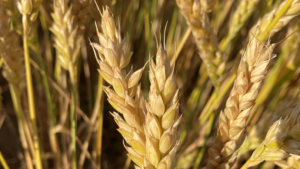U.S. grain and oilseed industry
2023 POLICY DEVELOPMENT PRIORITIES

GLOBAL EVENTS HAVE dominated grain organizations’ agendas on both sides of the Canada-U.S. border. Volatile markets, soaring input prices, and supply chain disruptions have kept farmers and their respective commodity representatives busy as they work to manage and mitigate new and ongoing risks on the farm and on behalf of farming members.
U.S. corn, soybean, and wheat organizations worked diligently in 2022, advocating for manageable input costs, secure safety net programs, and to address consumer fears of rising food prices, all in the face of constant global uncertainty. On top of everything else, the current U.S. Farm Bill is set to expire in September 2023, making the renewal of such an integral package of legislation another priority on the list for the American Soybean Association (ASA), National Corn Growers Association (NCGA), and the National Association of Wheat Growers (NAWG).
Ontario Grain Farmer checked in with our U.S. counterparts to learn more about how the 2023 Farm Bill was shaping up, what is on the minds of their growers, and what is on their agenda for the coming year.
AMERICAN SOYBEAN ASSOCIATION
Grain Farmers of Ontario is a State Affiliate member of the ASA, and is represented by Jeff Harrison on the ASA board of directors. Harrison is the Grain Farmers of Ontario director for District 12 (Durham, Northumberland, Kawartha, Peterborough, Hastings). He farms in the City of Quinte West, Ontario. Harrison says that in 2022, the ASA’s top priorities were measures to protect the farm economy, sustain and build markets, and assure movement to and from those markets. Supply chain disruptions were also an ongoing challenge for U.S. soybean farmers, especially in early 2022, when the industry was still feeling the lingering effects of the pandemic and the Russian invasion of Ukraine. Throughout the year, farmers also dealt with weather issues and the same ongoing global supply chain issues that Canadians have faced, like high fertilizer costs and climbing interest rates. Maintaining a steady workforce has also been a concern for many ASA members.
In May 2022, ASA was the first agricultural group to share its initial 2023 Farm Bill priorities with members of Congress in an effort to help shape the new legislation.
ASA’s first ask for the new Farm Bill is for increased budget authority. Harrison says that given the current economic and geopolitical volatility environment, ASA feels this request is justified. Additional resources are needed to address agriculture’s needs and interests in this comprehensive piece of legislation. ASA’s Farm Bill priority areas include farm safety net, conservation, trade, energy, rural development, research, and nutrition. They are also advocating for Congress to maintain the agricultural and nutrition titles (category areas of the bill), a review of the United States Department of Agriculture staffing, technological capabilities and cybersecurity, and knowledge transfer to ensure preparation for the 2023 Farm Bill implementation.
Harrison says trade and international markets are always a big deal for U.S. soybeans. With the United States-Mexico-Canada Agreement (USMCA) in place, ASA has had an eye on implementation and continues to urge engagement in new free trade agreements. He also notes the importance of infrastructure and keeping roads, waterways, and rail updated and maintained, noting that moving soybeans to and from markets is key to its global competitiveness.
As an organization, ASA leaders are closely monitoring supply chain issues and sufficient support, affordable input supplies, and a steady workforce to enhance food security. On the biotechnology and crop protection side, supporting science and risk-based regulations and continued access to farm production tools that farmers need is another ongoing concern. And just like Canadian farmers, conservation and sustainability are a priority, too: ASA continues to advocate for voluntary, incentive-based policies that support sustainability goals that are meaningful, realistic, and achievable for farmers.
NATIONAL CORN GROWERS ASSOCIATION
Tom Haag, a Minnesota corn and soybean grower, was elected president of NCGA in October 2022. He says the coming year is shaping up to be a big one for American corn farmers, with the establishment of a new Farm Bill and opportunities for ethanol topping Haag’s list.
The NCGA, corn state associations, and grower members will continue working closely with policymakers to ensure the bill addresses the needs of corn producers. NCGA’s principles for the 2023 Farm Bill include protecting crop insurance, bolstering U.S. international market development efforts, strengthening the producer safety net, supporting voluntary conservation programs, and championing initiatives important to rural America.
With crop insurance as the number one priority for NCGA, Haag notes that, while the program is currently working well, it will be important to advocate for an increase in reference pricing. He would also like to see commodity programs like the Agriculture Risk Coverage and Price Loss Coverage continued and possibly increase the funding to these if funding allows.
The coming year also looks promising for U.S. corn farmers thanks to the Next Generation Fuel Act. This legislation could see ethanol blends of up to 30 per cent increase ethanol demand by more than five billion gallons per year and utilize 1.7 billion bushels of additional corn. The higher-octane fuel will reduce greenhouse gas emissions and meet the future needs of more advanced vehicles by taking advantage of the benefits of higher ethanol blends. The Next Generation Fuel Act would gradually ramp up the use of homegrown ethanol at U.S. gas stations.
NATIONAL ASSOCIATION OF WHEAT GROWERS
According to NAWG CEO Chandler Goule, the NAWG will continue to focus on advocating their Farm Bill priorities in 2023. Throughout 2022, NAWG offices testified during several Congressional hearings about the Farm Bill.
The fallout of Russia’s invasion of Ukraine surprised the wheat industry, generating significant uncertainty for U.S. wheat growers. The resulting volatility in grain markets and continued increase in prices for key inputs like fuel and fertilizer is a serious concern. Given the uncertainties surrounding the duration of the conflict, the NAWG expects volatility to continue in the market and have an impact on world supplies.
While wheat growers face continued volatility in 2023, they believe the 2023 Farm Bill provides the opportunity to make improvements and afford stability for producers. Crop insurance is NAWG’s number one priority. According to Goule, crop insurance is an incredibly important tool to help farmers mitigate their risk, and it is essential that the new legislation maintain the program’s effectiveness and accessibility as a primary tool to help avert cropping disasters. NAWG is advocating for new enhancements to the crop insurance program in the 2023 Farm Bill and updating the current reference price to accurately reflect the current cost of production.
U.S. wheat farmers rely on rail transportation to deliver their harvest from their farms to domestic or international consumers, making transportation another key priority area of the Farm Bill. Since the pandemic, growers have experienced a reduction in the quality and quantity of rail service. NAWG will also continue to address these concerns and expects rail service discussions to continue in 2023.
Looking ahead, NAWG will be advocating for wheat growers to help craft a Farm Bill that benefits wheat farmers and American agriculture in 2023. In addition to protecting crop insurance, the organization’s priorities for the new legislation include supporting financial and technical assistance provided through voluntary conservation programs and enhancing USDA’s market access and development programs to enhance trade.
2023 FARM BILL
Set to expire in September 2023, the current U.S. Farm Bill is the largest piece of packaged legislation in the U.S. government that funds and governs the nation’s food and agricultural system. The current five-year bill, an $867 billion piece of legislation, was signed by President Trump in December 2018.
The Farm Bill covers programs ranging from crop insurance and on-farm conservation programs to healthy food access for low-income families. This legislation significantly impacts how farmers manage their farm businesses.
Broken down into 12 different titles encompassing broad categories that address different programs, the current Farm Bill includes:
- Commodity programs – price income support and disaster assistance
- Conservation
- Trade – exports and international food assistance programs
- Nutritional programs
- Credit – government loans, private loan guarantees
- Rural development
- Research – agricultural research and extension
- Forestry – USDA Forestry Service
- Energy – renewable energy systems
- Horticulture – specialty crop, organic, and hemp production
- Crop Insurance
- Miscellaneous – supporting livestock and poultry production, beginning farmers, and ranchers •

























